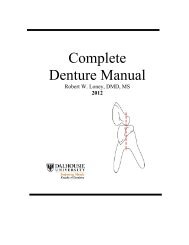RPD Manual 11 - Removable Prosthodontics - Dalhousie University
RPD Manual 11 - Removable Prosthodontics - Dalhousie University
RPD Manual 11 - Removable Prosthodontics - Dalhousie University
Create successful ePaper yourself
Turn your PDF publications into a flip-book with our unique Google optimized e-Paper software.
Direct and Indirect Retainers - 57<br />
Rotation of a partial denture about the fulcrum line is prevented by indirect retainers placed<br />
against definite rest seats on the opposite side of the fulcrum line from the distal extension base.<br />
Indirect retainers should be placed as far as possible from the distal extension base so as to gain<br />
the best possible leverage advantage against lifting of the distal extension base.<br />
Although, the most effective location of an indirect retainer is frequently in the vicinity of an<br />
incisor tooth, these teeth may not be strong enough to support an indirect retainer. In addition,<br />
incisors often have steep lingual inclines that cannot be favourably altered to support a rest. In<br />
such cases, the nearest canine tooth or the mesial occlusal surface of the first premolar may be<br />
the best location, despite the fact that it is not as far removed from the fulcrum line.<br />
The factors influencing the effectiveness of an indirect retainer include:<br />
1. Proper seating of the denture. Unless the principle occlusal rests are held in their seats by<br />
the action of the direct retainers, rotation about the fulcrum line will not occur and,<br />
therefore, an indirect retainer cannot act to prevent lifting of the distal extension base away<br />
from the tissues.<br />
2. Distance from the fulcrum line.<br />
3. The rigidity of the connectors supporting the indirect retainer. All connectors must be<br />
rigid if the indirect retainer is to function as intended.<br />
4. The effectiveness of the supporting tooth surface. The indirect retainer must be placed on a<br />
definite rest seat,, on which slippage or tooth movement will not occur. Tooth inclines and<br />
weak teeth should never be used for the support of indirect retainers.<br />
In addition to preventing movement of a distal extension base away from the tissues, an indirect<br />
retainer may serve the following auxiliary functions:<br />
1. It tends to reduce torquing leverages on the principle abutments. This is important when an<br />
isolated tooth is being used as an abutment (a situation that should be avoided whenever<br />
possible). Ordinarily, proximal contact with the adjacent tooth prevents such tilting of an<br />
abutment as the base lifts away from the tissues.<br />
2. Contact of the indirect retainer’s minor connector with vertical tooth surface aids in<br />
stabilization against horizontal movement of the denture. Such tooth surfaces, when made<br />
parallel to the path of placement, may also act as auxiliary guiding planes.















